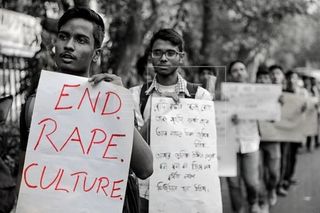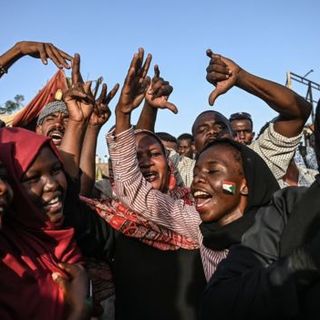
What It Will Take to End Gang Rapes in India
Even the harshest penalties imposed on rapists will not dismantle the rape culture that conditions them in the first place.

We’d be lying if we didn’t acknowledge the déjà vu all of us have been quietly feeling for the past few days. Publicly — among friends and family, on social media, in op-eds and columns — we have come forth to angrily mourn a flurry of fatal, heinous gang rapes the country is witnessing, but privately — in the quickened heartbeat while reading graphic details of yet another woman brutalized — we know we’ve been at this tipping point before. We were here after the 2012 Delhi gang-rape case; we were here after the 2016 Kathua gang rape case; it’s morbid how almost all of us quietly know that we will be at this point again.
But there’s another experience, perhaps more common to all of us: the daily, unremitting drip-drip of sexism and misogyny that leads to these tipping points of sexual violence, which we collectively enforce, ignore, and accept.
If we want to move the needle forward — that is to say, really uproot the pandemic of sexual violence from human society for good — connecting the dots between the two is essential. The anger we all feel after cases such as the recent Hyderabad gang rape–murder, in which four men gang-raped, killed and burned a 26-year-old veterinarian, is rightfully proportional to the monstrosity of the crime. But in our selective bursts of anger and desire for reform, we are failing to see the bigger picture.
Rape exists as an extreme on one end of a spectrum of rape culture. There’s an intimidatingly long list of behaviors, beliefs, and norms, more subtle and benign than rape, that contributes to this culture, that we all learn as a social script; combating rape, then, necessitates we dismantle this culture. As long as sexist statements such as “men will be men” are used to justify victim-blaming and -shaming, groping in public spaces, birth control sabotage, sending unsolicited nude pictures and catcalling, men will rape women. As long as sexist language, rape jokes, and other forms of sexist humor are fodder for social bonding, men will rape women.
In response to the recent Hyderabad gang rape case, Telangana Chief Minister K Chandrashekhar Rao imposed an 8 pm curfew on women employees of the Telangana State Road Transport Corporation and prohibited them from working night shifts. This belief — that keeping our women and girls indoors will stop rape — is a direct result of a society in which male aggression is normal and maleness equals violence. As long as we accept rape as something inevitable in our culture, because men will be men, not only will men rape women, but just the threat of sexual violence will continue to be used to curtail women’s freedoms and then justify violations should women exercise agency.
This belief — that men will be men — manifests in more subtle, but equally urgent issues to be solved, such as why misogynistic movies like Kabir Singh arewelcomed with raucous applause and box office success, why Salman Khan, an alleged sexual and physical abuser and murderer, is accorded superstar status, and, why most of the men accused in the #MeToo movement have gone back to living their privileged lives.
Related on The Swaddle:
Study: 3.35 Million U.S. Women’s First Sexual Experience Was Rape
Rapists don’t rape only because they want sex; it’s not that they are suddenly, uncontrollably turned on by the sight of a woman. Rape is about power and the sexually violent nature of the exertion of that power. That power is accorded to men who rape by the same culture that cultivates a binary of the good, modest, virgin woman and the bad, jarring slut, which further supplements sexist norms about the ideal, subservient, ever-consenting wife and the breadwinning, dominant man of the house.
Incidentally, globally, one in three men verbally, sexually, physically and/or psychologically abuse their wives, partners or exes. The latest National Family Health Survey (NFHS-4) suggests that 31% of married women have been physically, sexually or emotionally abused by their husbands; by other estimates, 52% of women in India believe men are entitled to abuse their wives, while more than 40% of men believe that women should tolerate violence if it means keeping the family together. All this is rape culture — and the assumption of men’s ownership of women’s sexualities and bodies that is implicit in it is also why marital rape is still legal in India.
If rape is about power then rape culture endows men with that power over women, including power over their sexuality and bodies. This leads to women’s overt sexualization that depicts them as passive objects for men to use. From seemingly benign behaviors such as our mothers telling us to cover up when male relatives come home to the multi-billion cosmetic, fashion and lingerie industries that exploit young girls to sell products and that is founded on the idea of the female form as something to be enhanced, possessed, and consumed by the male gaze — the culture that sexualizes women in these ways is the same culture that facilitates rape.
This power that men have over women’s bodies and sexualities — which they exert in one of its most extreme manifestations when they rape — is also the driving force behind restrictions to women’s abortion access, virginity tests, two-finger rape tests, female genital mutilation, norms about women’s value based on their clothing and sexual appetite, and the porn industry.
Patriarchy’s hyperfocus on controlling female bodies and promoting heterosexual sex is also the reason why homosexuality is still largely considered unnatural by Indian society, and why the Indian Parliament recently passed the regressive Transgender Persons (Protection of Rights) Bill, 2019, that allows for a less punishment for rapists of trans people, as opposed to rapists of cis-gendered women — without so much as talking to people from the trans community.
Related on The Swaddle:
News Reporting of Sexual Violence Is Propagating Rape Culture
Vindictive reforms might feel cathartic in the face of helpless hashtags, but what will be more effective is calling out rape culture every day — before it escalates and results in the rape (sensational enough) of a woman (upper caste enough) or by men (lower-caste or lower-class enough) for us to rage. Admittedly, hanging or castrating the rapists is much easier than systematically dismantling rape culture, which will take time and hyper-awareness of how deeply it is embedded in our everyday reality. But, it’s the easy way out — and it only blurs the role rape culture plays in enabling men to rape this much, and with this severity.
Our conversation about rape can’t begin at rape. It especially can’t begin at only few, albeit horrific, rapes every few years, not when men rape a woman every 20 minutes in India. Our conversation about rape cannot ignore the fact that women who are most likely to be raped are those who live in the margins — women from lower caste and classes and women with different abilities, sexualities or gender identities — and hence are less likely to speak up or be heard, let alone be given so much media and political attention, to even reach us in the first place.
Until our conversation about rape remains divorced from the culture that feeds it and the society that empowers it and does not include the 99% of cases of sexual violence that go unreported, we will be at this tipping point again.
Pallavi Prasad is The Swaddle's Features Editor. When she isn't fighting for gender justice and being righteous, you can find her dabbling in street and sports photography, reading philosophy, drowning in green tea, and procrastinating on doing the dishes.
Related


Loneliness Isn’t a Medical Problem; It’s Evidence of a Broken Society
